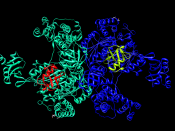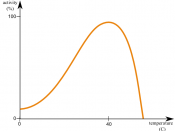Leonardo Mitchell
Biology
Enzymes
Enzymes are proteins made up of amino acids, which act as biological catalysts. This means they speed up chemical reactions that take place in all cells. They are the ones which determine whether a substance is broken down or built up. In reactions that include enzymes, the molecules, which react, are called substrates, which have a complementary relation with the active site, and the produced molecules are called products. When and enzyme encounters a complementary substrate molecule, they become an enzyme substrate complex which then reacts giving the enzyme and the product molecules Enzymes are involved in both catabolic and anabolic reactions. Catabolic reactions break down large molecules into much smaller ones as oppose to anabolic reactions which build up smaller molecules to larger molecules. There are thousands of different enzymes, all having different shapes and functions caused by the order of amino acids, which all control what happens to a molecule by either being present or absent in an anabolic or catabolic reaction, each enzyme catalysing a different reaction.
Some examples of enzymes are: Protease, Catalase, Lipase, Maltose and many, many more. There are many factors, which affect the activity rate of an enzyme: Substrate concentration, temperature, pH, Enzyme concentration and more.
As they are catalysts, they are not affected by the reaction they are speeding up but they are affected by temperature and pH conditions. Increased heat energy causes the movement of substrate molecules to speed up causing them to have more energy when they collide with the enzyme making them more probable to bind with the active site, which is where the reaction occurs. When there is a lower thermal energy, there will be less successful collisions. Higher temperature increases also directly affect the enzymes themselves, which begin vibrating until they are denatured,


